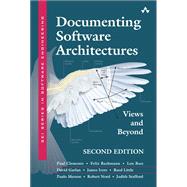
Note: Supplemental materials are not guaranteed with Rental or Used book purchases.
Purchase Benefits
What is included with this book?
Felix Bachmann is a Senior Member of the Technical Staff at the SEI, working in the Architecture Centric Engineering Initiative. He is coauthor of the Attribute-Driven Design Method, a contributor to and instructor for the ATAM Evaluator Training course, and a contributor to the book Software Architecture in Practice, Second Edition. Before joining the SEI, he was a software engineer at Robert Bosch GmbH in corporate research, where he worked with software development departments to address the issues of software engineering in small and large embedded systems.
Len Bass is a Senior Member of the Technical Staff at the SEI. He has coauthored two award-winning books in software architecture as well as several other books and numerous papers in a wide variety of areas of computer science and software engineering. He has been a keynote speaker or a distinguished lecturer on six continents. He is currently working on applying the concepts of ultra-large-scale systems to the smart grid. He has been involved in the development of numerous different production or research software systems, ranging from operating systems to database management systems to automotive systems. He is a member of the IFIP Working Group on Software Architecture (WG2.10).
David Garlan is a Professor of Computer Science and Director of Software Engineering Professional Programs in the School of Computer Science at Carnegie Mellon University (CMU). He received his Ph.D. from CMU in 1987 and worked as a software architect in industry between 1987 and 1990. His interests include software architecture, self-adaptive systems, formal methods, and cyber-physical systems. He is considered to be one of the founders of the field of software architecture and, in particular, formal representation and analysis of architectural designs. In 2005 he received a Stevens Award Citation for fundamental contributions to the development and understanding of software architecture as a discipline in software engineering.
James Ivers is a Senior Member of the Technical Staff at the SEI, where he works in the areas of software architecture and program analysis. He received a Master of Software Engineering from CMU in 1996 and has worked for and with a variety of development organizations, from start-up to multinational corporations. He has written numerous papers, contributed to the development of an international standard for distributed simulations, and has recently been working in a public-private collaboration to draft security recommendations for the smart grid.
Reed Little is a Senior Member of the Technical Staff at the SEI. He applies more than 35 years of experience in computer simulation, software architecture, software product lines, man-machine interface, artificial intelligence, and programming language design to various aspects of applied research and hands-on customer assistance for large (more than three million lines of code) software systems.
Paulo Merson has more than 20 years of software development experience. He works for the SEI in the areas of software architecture, service-oriented architecture, and aspect-oriented software development. He is also a practicing software architect in industry. One of his assignments at the SEI is to teach a two-day course in “Documenting Software Architectures” for industry and government practitioners. His speaking experience also includes tutorials at various conferences, such as SD Best Practices, Dr. Dobb’s Architecture & Design World, and JavaOne. Prior to joining the SEI, he was a Java EE consultant. Paulo holds a B.Sc. in Computer Science from University of Brasilia, and a Master of Software Engineering from CMU.
Robert Nord is a Senior Member of the Technical Staff in the Research, Technology, and System Solutions Program at the SEI, where he works to develop and communicate effective methods and practices for software architecture. He is coauthor of the practitioner-oriented book Applied Software Architecture (Addison-Wesley, 2000) and lectures on architecture-centric approaches. He is a member of the IFIP Working Group on Software Architecture (WG2.10).
Judith Stafford is a Senior Lecturer at Tufts University and a Visiting Scientist at the SEI. Before joining the faculty at Tufts University, she was a Senior Member of the Technical Staff at the SEI in the Product Lines Systems Program, working in the Software Architecture Technologies Initiative. She has authored several book chapters on the topic of software architecture analysis, software architecture support for software component composition, and software architecture documentation. Stafford has been an organizer and program committee member for several conferences and workshops, and a guest editor on several leading software engineering journal special issues. She received her Ph.D. and M.S. degrees in Computer Science from the University of Colorado at Boulder. She is a member of the IEEE Computer Society, ACM SIGSOFT and SIGPLAN, and the IFIP Working Group on Software Architecture (WG2.10).
| About the Cover | |
| Forward | |
| Preface | |
| Reader's Guide | |
| Prologue: Software Architectures and Documentation | |
| Software Architecture Viewtypes and Styles | |
| The Module Viewtype | |
| Styles of the Module Viewtype | |
| The Component-and-Connector Viewtype | |
| Styles of the Component-and-Connector Viewtype | |
| The Allocation Viewtype and Styles | |
| Software Architecture Documentation in Practice | |
| Advanced Concepts | |
| Documenting Software Interfaces | |
| Documenting Behavior | |
| Choosing the Views | |
| Building the Documentation Package | |
| Other Views and Beyond | |
| Excerpts from a Software Architecture Documentation Package | |
| Table of Contents provided by Publisher. All Rights Reserved. |
The New copy of this book will include any supplemental materials advertised. Please check the title of the book to determine if it should include any access cards, study guides, lab manuals, CDs, etc.
The Used, Rental and eBook copies of this book are not guaranteed to include any supplemental materials. Typically, only the book itself is included. This is true even if the title states it includes any access cards, study guides, lab manuals, CDs, etc.